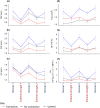Groundwater extraction reduces tree vitality, growth and xylem hydraulic capacity in Quercus robur during and after drought events
- PMID: 33664306
- PMCID: PMC7970862
- DOI: 10.1038/s41598-021-84322-6
Groundwater extraction reduces tree vitality, growth and xylem hydraulic capacity in Quercus robur during and after drought events
Abstract
Climate change is expected to pose major direct and indirect threats to groundwater-dependent forest ecosystems. Forests that concurrently experience increased rates of water extraction may face unprecedented exposure to droughts. Here, we examined differences in stem growth and xylem hydraulic architecture of 216 oak trees from sites with contrasting groundwater availability, including sites where groundwater extraction has led to reduced water availability for trees over several decades. We expected reduced growth and xylem hydraulic capacity for trees at groundwater extraction sites both under normal and unfavourable growing conditions. Compared to sites without extraction, trees at sites with groundwater extraction showed reduced growth and hydraulic conductivity both during periods of moderate and extremely low soil water availability. Trees of low vigour, which were more frequent at sites with groundwater extraction, were not able to recover growth and hydraulic capacity following drought, pointing to prolonged drought effects. Long-term water deficit resulting in reduced CO2 assimilation and hydraulic capacity after drought are very likely responsible for observed reductions in tree vitality at extraction sites. Our results demonstrate that groundwater access maintains tree function and resilience to drought and is therefore important for tree health in the context of climate change.
Conflict of interest statement
The authors declare no competing interests.
Figures







Similar articles
-
Climate sensitivity and drought seasonality determine post-drought growth recovery of Quercus petraea and Quercus robur in Europe.Sci Total Environ. 2021 Aug 25;784:147222. doi: 10.1016/j.scitotenv.2021.147222. Epub 2021 Apr 21. Sci Total Environ. 2021. PMID: 34088042
-
Greater hydraulic safety contributes to higher growth resilience to drought across seven pine species in a semi-arid environment.Tree Physiol. 2022 Apr 7;42(4):727-739. doi: 10.1093/treephys/tpab137. Tree Physiol. 2022. PMID: 34718811
-
Stem hydraulic capacitance decreases with drought stress: implications for modelling tree hydraulics in the Mediterranean oak Quercus ilex.Plant Cell Environ. 2017 Aug;40(8):1379-1391. doi: 10.1111/pce.12928. Epub 2017 Feb 24. Plant Cell Environ. 2017. PMID: 28152583
-
Effect of soil water availability on intra-annual xylem and phloem formation and non-structural carbohydrate pools in stem of Quercus pubescens.Tree Physiol. 2019 Feb 1;39(2):222-233. doi: 10.1093/treephys/tpy101. Tree Physiol. 2019. PMID: 30239939
-
Coexisting oak species, including rear-edge populations, buffer climate stress through xylem adjustments.Tree Physiol. 2018 Feb 1;38(2):159-172. doi: 10.1093/treephys/tpx157. Tree Physiol. 2018. PMID: 29300954
Cited by
-
Quantitative vessel mapping on increment cores: a critical comparison of image acquisition methods.Front Plant Sci. 2025 Feb 12;16:1502237. doi: 10.3389/fpls.2025.1502237. eCollection 2025. Front Plant Sci. 2025. PMID: 40012731 Free PMC article.
-
Biodiversity and Management as Central Players in the Network of Relationships Underlying Forest Resilience.Glob Chang Biol. 2025 May;31(5):e70196. doi: 10.1111/gcb.70196. Glob Chang Biol. 2025. PMID: 40351244 Free PMC article. Review.
References
-
- Allen CD, et al. A global overview of drought and heat-induced tree mortality reveals emerging climate change risks for forests. For. Ecol. Manag. 2010;259:660–684. doi: 10.1016/j.foreco.2009.09.001. - DOI
-
- Allen CD, Breshears DD, McDowell NG. On underestimation of global vulnerability to tree mortality and forest die-off from hotter drought in the Anthropocene. Ecosphere. 2015;6:1–55. doi: 10.1890/ES15-00203.1. - DOI
Publication types
LinkOut - more resources
Full Text Sources
Other Literature Sources

